Understanding Historical Cost and Fair Value Principles in Business Accounting
VerifiedAdded on 2022/12/28
|13
|1915
|77
AI Summary
This business report discusses the pros and cons of Historical Cost Principle and Fair Value Principle in business accounting. It provides recommendations on which principle to follow and explains how these principles impact financial reporting and asset valuation.
Contribute Materials
Your contribution can guide someone’s learning journey. Share your
documents today.
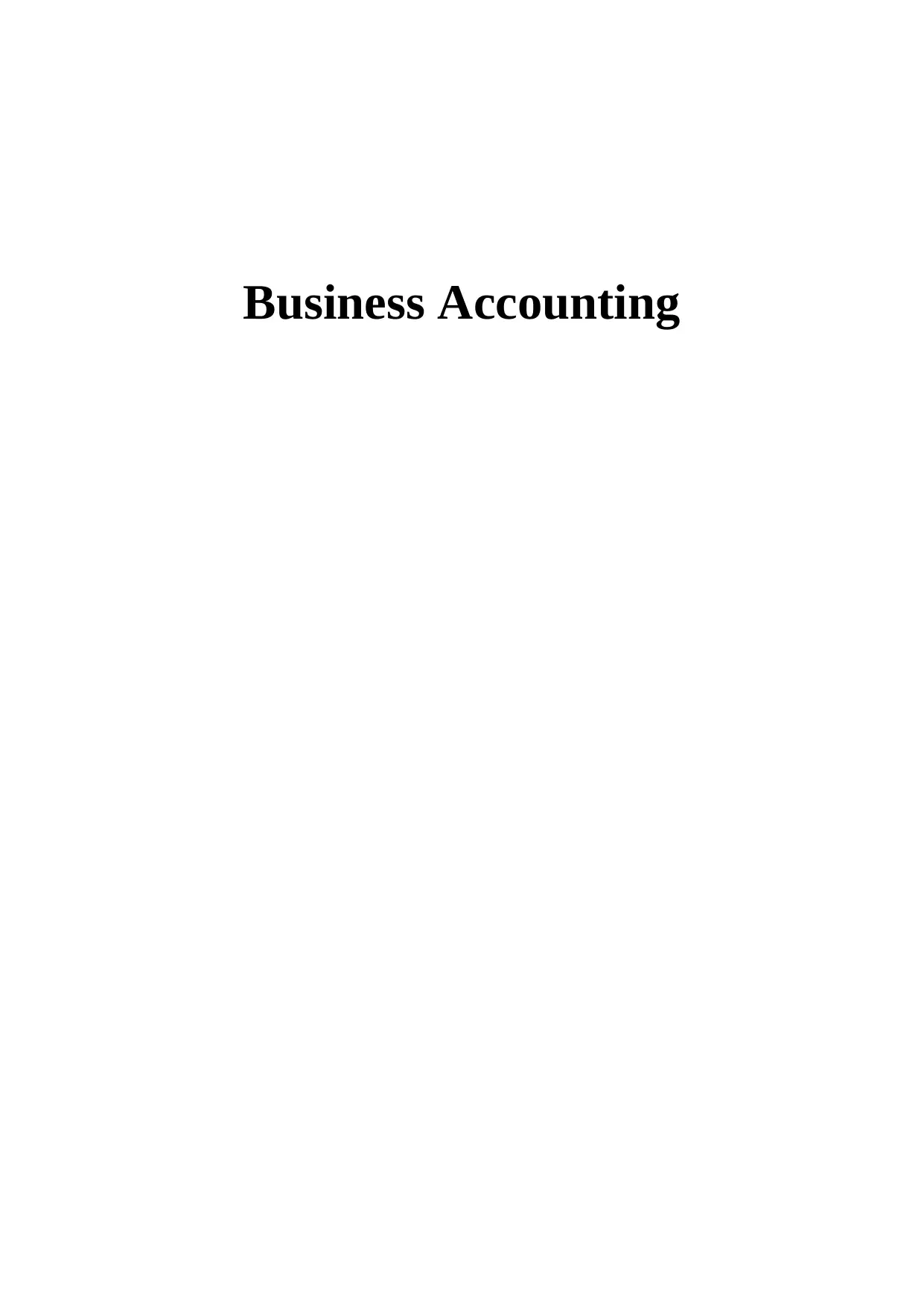
Business Accounting
Secure Best Marks with AI Grader
Need help grading? Try our AI Grader for instant feedback on your assignments.
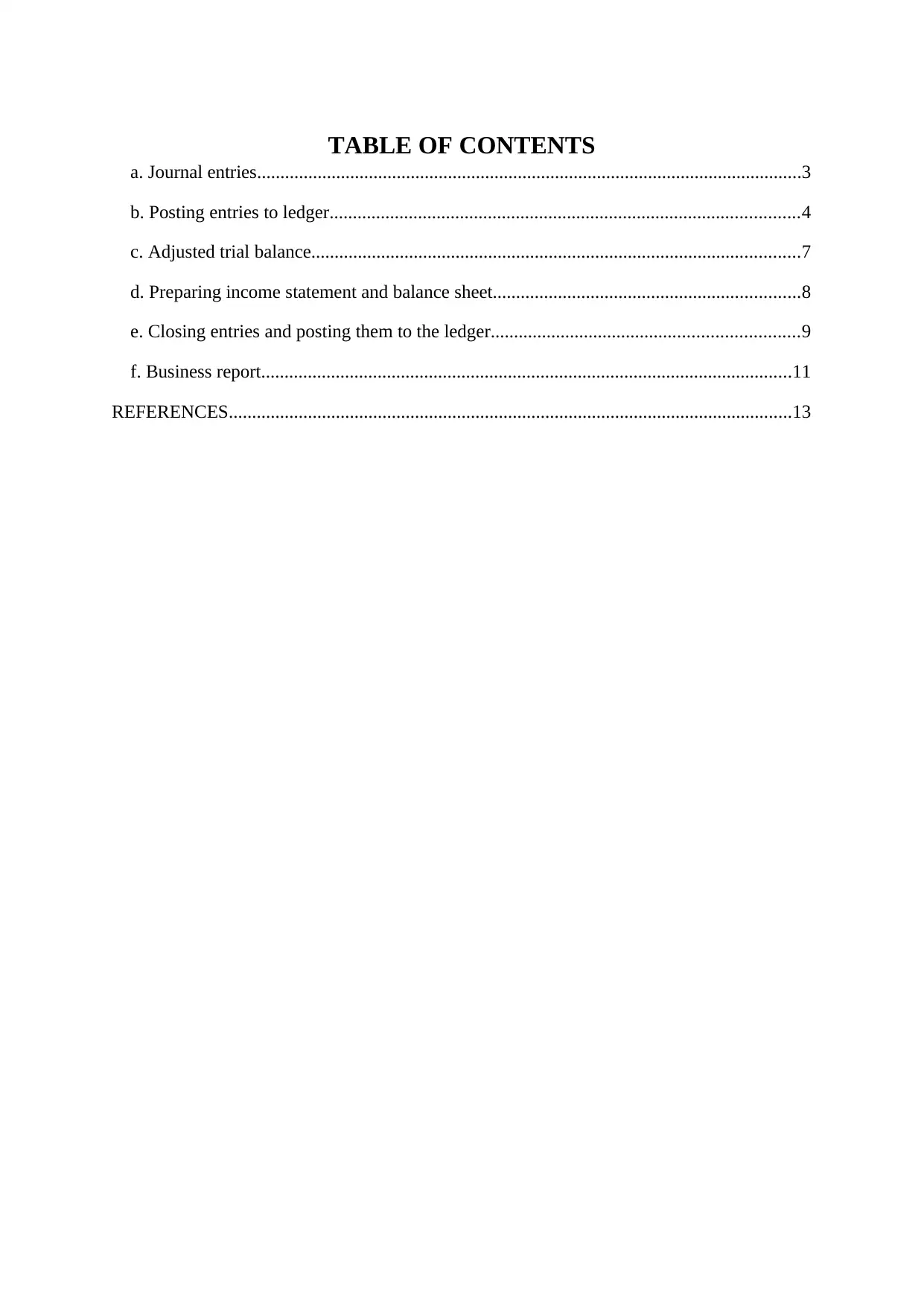
TABLE OF CONTENTS
a. Journal entries.....................................................................................................................3
b. Posting entries to ledger.....................................................................................................4
c. Adjusted trial balance.........................................................................................................7
d. Preparing income statement and balance sheet..................................................................8
e. Closing entries and posting them to the ledger..................................................................9
f. Business report..................................................................................................................11
REFERENCES.........................................................................................................................13
a. Journal entries.....................................................................................................................3
b. Posting entries to ledger.....................................................................................................4
c. Adjusted trial balance.........................................................................................................7
d. Preparing income statement and balance sheet..................................................................8
e. Closing entries and posting them to the ledger..................................................................9
f. Business report..................................................................................................................11
REFERENCES.........................................................................................................................13
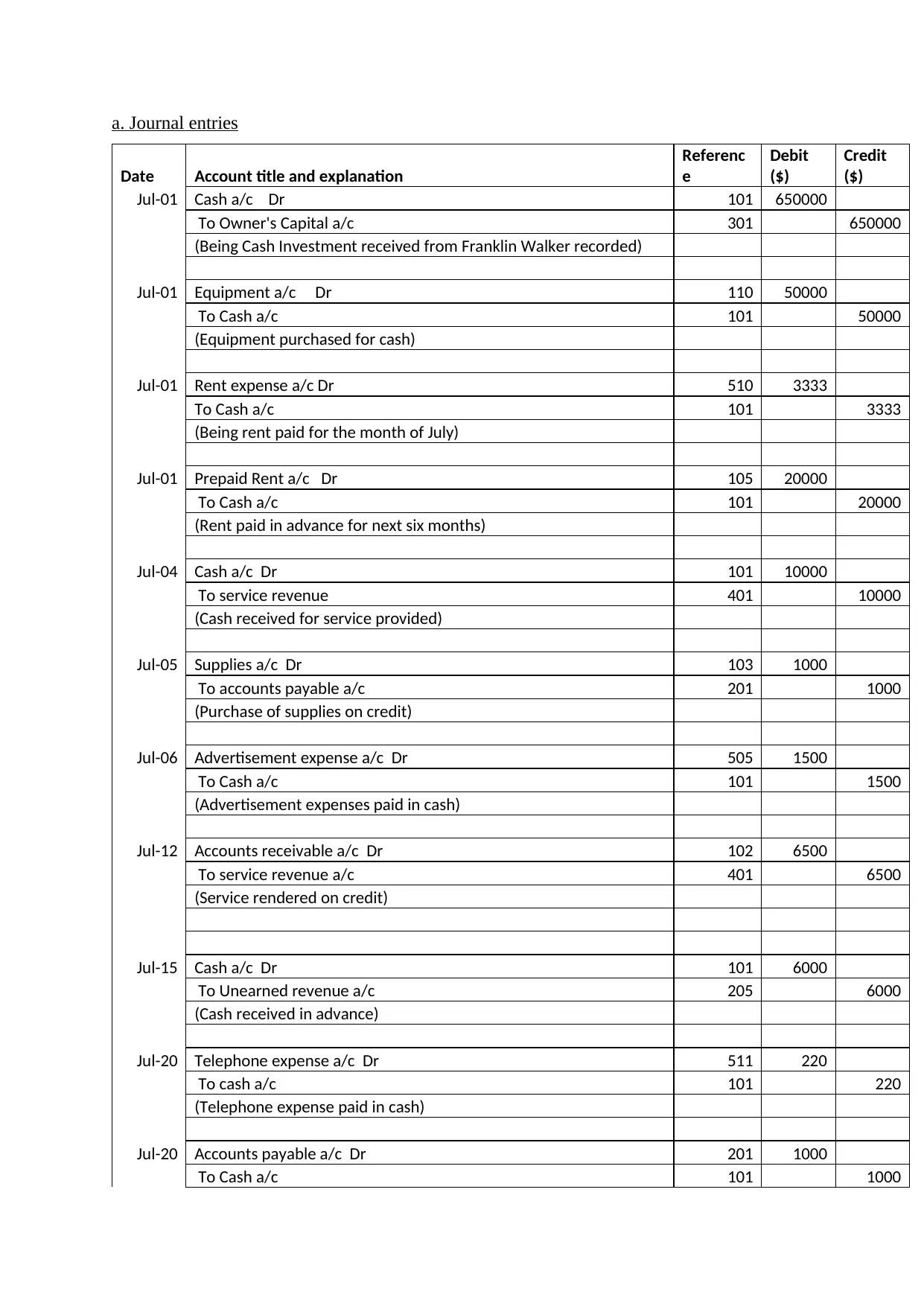
a. Journal entries
Date Account title and explanation
Referenc
e
Debit
($)
Credit
($)
Jul-01 Cash a/c Dr 101 650000
To Owner's Capital a/c 301 650000
(Being Cash Investment received from Franklin Walker recorded)
Jul-01 Equipment a/c Dr 110 50000
To Cash a/c 101 50000
(Equipment purchased for cash)
Jul-01 Rent expense a/c Dr 510 3333
To Cash a/c 101 3333
(Being rent paid for the month of July)
Jul-01 Prepaid Rent a/c Dr 105 20000
To Cash a/c 101 20000
(Rent paid in advance for next six months)
Jul-04 Cash a/c Dr 101 10000
To service revenue 401 10000
(Cash received for service provided)
Jul-05 Supplies a/c Dr 103 1000
To accounts payable a/c 201 1000
(Purchase of supplies on credit)
Jul-06 Advertisement expense a/c Dr 505 1500
To Cash a/c 101 1500
(Advertisement expenses paid in cash)
Jul-12 Accounts receivable a/c Dr 102 6500
To service revenue a/c 401 6500
(Service rendered on credit)
Jul-15 Cash a/c Dr 101 6000
To Unearned revenue a/c 205 6000
(Cash received in advance)
Jul-20 Telephone expense a/c Dr 511 220
To cash a/c 101 220
(Telephone expense paid in cash)
Jul-20 Accounts payable a/c Dr 201 1000
To Cash a/c 101 1000
Date Account title and explanation
Referenc
e
Debit
($)
Credit
($)
Jul-01 Cash a/c Dr 101 650000
To Owner's Capital a/c 301 650000
(Being Cash Investment received from Franklin Walker recorded)
Jul-01 Equipment a/c Dr 110 50000
To Cash a/c 101 50000
(Equipment purchased for cash)
Jul-01 Rent expense a/c Dr 510 3333
To Cash a/c 101 3333
(Being rent paid for the month of July)
Jul-01 Prepaid Rent a/c Dr 105 20000
To Cash a/c 101 20000
(Rent paid in advance for next six months)
Jul-04 Cash a/c Dr 101 10000
To service revenue 401 10000
(Cash received for service provided)
Jul-05 Supplies a/c Dr 103 1000
To accounts payable a/c 201 1000
(Purchase of supplies on credit)
Jul-06 Advertisement expense a/c Dr 505 1500
To Cash a/c 101 1500
(Advertisement expenses paid in cash)
Jul-12 Accounts receivable a/c Dr 102 6500
To service revenue a/c 401 6500
(Service rendered on credit)
Jul-15 Cash a/c Dr 101 6000
To Unearned revenue a/c 205 6000
(Cash received in advance)
Jul-20 Telephone expense a/c Dr 511 220
To cash a/c 101 220
(Telephone expense paid in cash)
Jul-20 Accounts payable a/c Dr 201 1000
To Cash a/c 101 1000
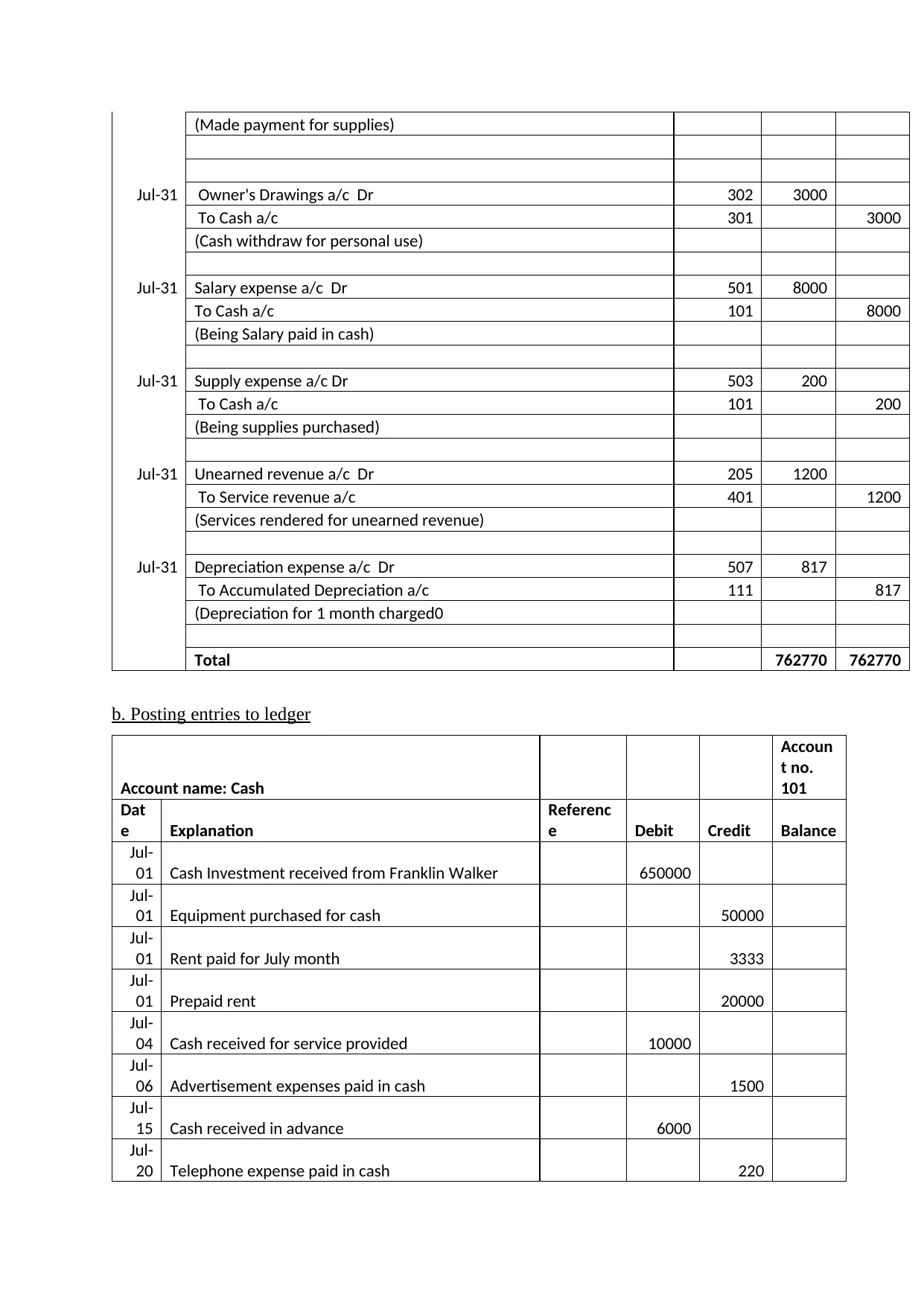
(Made payment for supplies)
Jul-31 Owner's Drawings a/c Dr 302 3000
To Cash a/c 301 3000
(Cash withdraw for personal use)
Jul-31 Salary expense a/c Dr 501 8000
To Cash a/c 101 8000
(Being Salary paid in cash)
Jul-31 Supply expense a/c Dr 503 200
To Cash a/c 101 200
(Being supplies purchased)
Jul-31 Unearned revenue a/c Dr 205 1200
To Service revenue a/c 401 1200
(Services rendered for unearned revenue)
Jul-31 Depreciation expense a/c Dr 507 817
To Accumulated Depreciation a/c 111 817
(Depreciation for 1 month charged0
Total 762770 762770
b. Posting entries to ledger
Account name: Cash
Accoun
t no.
101
Dat
e Explanation
Referenc
e Debit Credit Balance
Jul-
01 Cash Investment received from Franklin Walker 650000
Jul-
01 Equipment purchased for cash 50000
Jul-
01 Rent paid for July month 3333
Jul-
01 Prepaid rent 20000
Jul-
04 Cash received for service provided 10000
Jul-
06 Advertisement expenses paid in cash 1500
Jul-
15 Cash received in advance 6000
Jul-
20 Telephone expense paid in cash 220
Jul-31 Owner's Drawings a/c Dr 302 3000
To Cash a/c 301 3000
(Cash withdraw for personal use)
Jul-31 Salary expense a/c Dr 501 8000
To Cash a/c 101 8000
(Being Salary paid in cash)
Jul-31 Supply expense a/c Dr 503 200
To Cash a/c 101 200
(Being supplies purchased)
Jul-31 Unearned revenue a/c Dr 205 1200
To Service revenue a/c 401 1200
(Services rendered for unearned revenue)
Jul-31 Depreciation expense a/c Dr 507 817
To Accumulated Depreciation a/c 111 817
(Depreciation for 1 month charged0
Total 762770 762770
b. Posting entries to ledger
Account name: Cash
Accoun
t no.
101
Dat
e Explanation
Referenc
e Debit Credit Balance
Jul-
01 Cash Investment received from Franklin Walker 650000
Jul-
01 Equipment purchased for cash 50000
Jul-
01 Rent paid for July month 3333
Jul-
01 Prepaid rent 20000
Jul-
04 Cash received for service provided 10000
Jul-
06 Advertisement expenses paid in cash 1500
Jul-
15 Cash received in advance 6000
Jul-
20 Telephone expense paid in cash 220
Secure Best Marks with AI Grader
Need help grading? Try our AI Grader for instant feedback on your assignments.
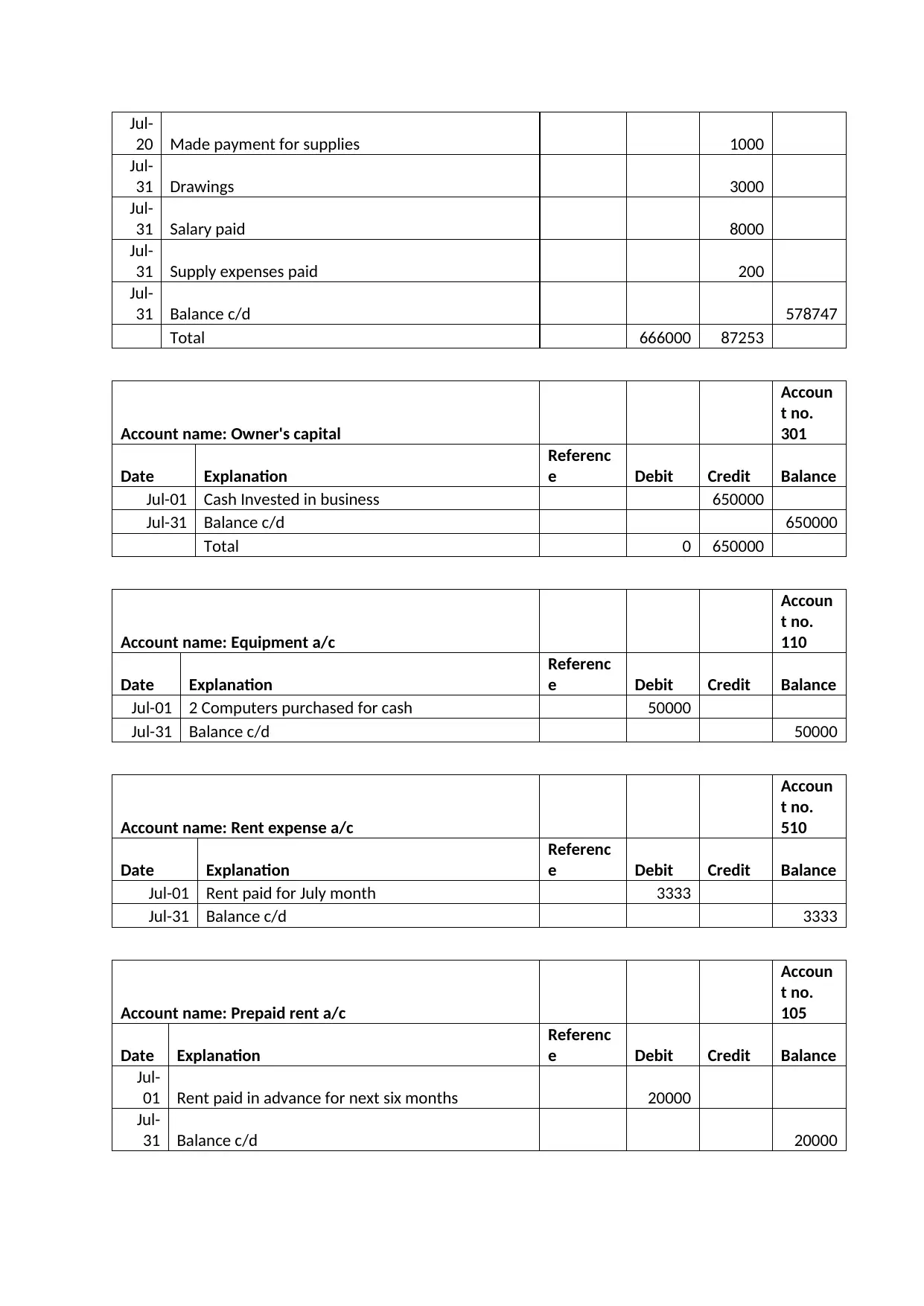
Jul-
20 Made payment for supplies 1000
Jul-
31 Drawings 3000
Jul-
31 Salary paid 8000
Jul-
31 Supply expenses paid 200
Jul-
31 Balance c/d 578747
Total 666000 87253
Account name: Owner's capital
Accoun
t no.
301
Date Explanation
Referenc
e Debit Credit Balance
Jul-01 Cash Invested in business 650000
Jul-31 Balance c/d 650000
Total 0 650000
Account name: Equipment a/c
Accoun
t no.
110
Date Explanation
Referenc
e Debit Credit Balance
Jul-01 2 Computers purchased for cash 50000
Jul-31 Balance c/d 50000
Account name: Rent expense a/c
Accoun
t no.
510
Date Explanation
Referenc
e Debit Credit Balance
Jul-01 Rent paid for July month 3333
Jul-31 Balance c/d 3333
Account name: Prepaid rent a/c
Accoun
t no.
105
Date Explanation
Referenc
e Debit Credit Balance
Jul-
01 Rent paid in advance for next six months 20000
Jul-
31 Balance c/d 20000
20 Made payment for supplies 1000
Jul-
31 Drawings 3000
Jul-
31 Salary paid 8000
Jul-
31 Supply expenses paid 200
Jul-
31 Balance c/d 578747
Total 666000 87253
Account name: Owner's capital
Accoun
t no.
301
Date Explanation
Referenc
e Debit Credit Balance
Jul-01 Cash Invested in business 650000
Jul-31 Balance c/d 650000
Total 0 650000
Account name: Equipment a/c
Accoun
t no.
110
Date Explanation
Referenc
e Debit Credit Balance
Jul-01 2 Computers purchased for cash 50000
Jul-31 Balance c/d 50000
Account name: Rent expense a/c
Accoun
t no.
510
Date Explanation
Referenc
e Debit Credit Balance
Jul-01 Rent paid for July month 3333
Jul-31 Balance c/d 3333
Account name: Prepaid rent a/c
Accoun
t no.
105
Date Explanation
Referenc
e Debit Credit Balance
Jul-
01 Rent paid in advance for next six months 20000
Jul-
31 Balance c/d 20000
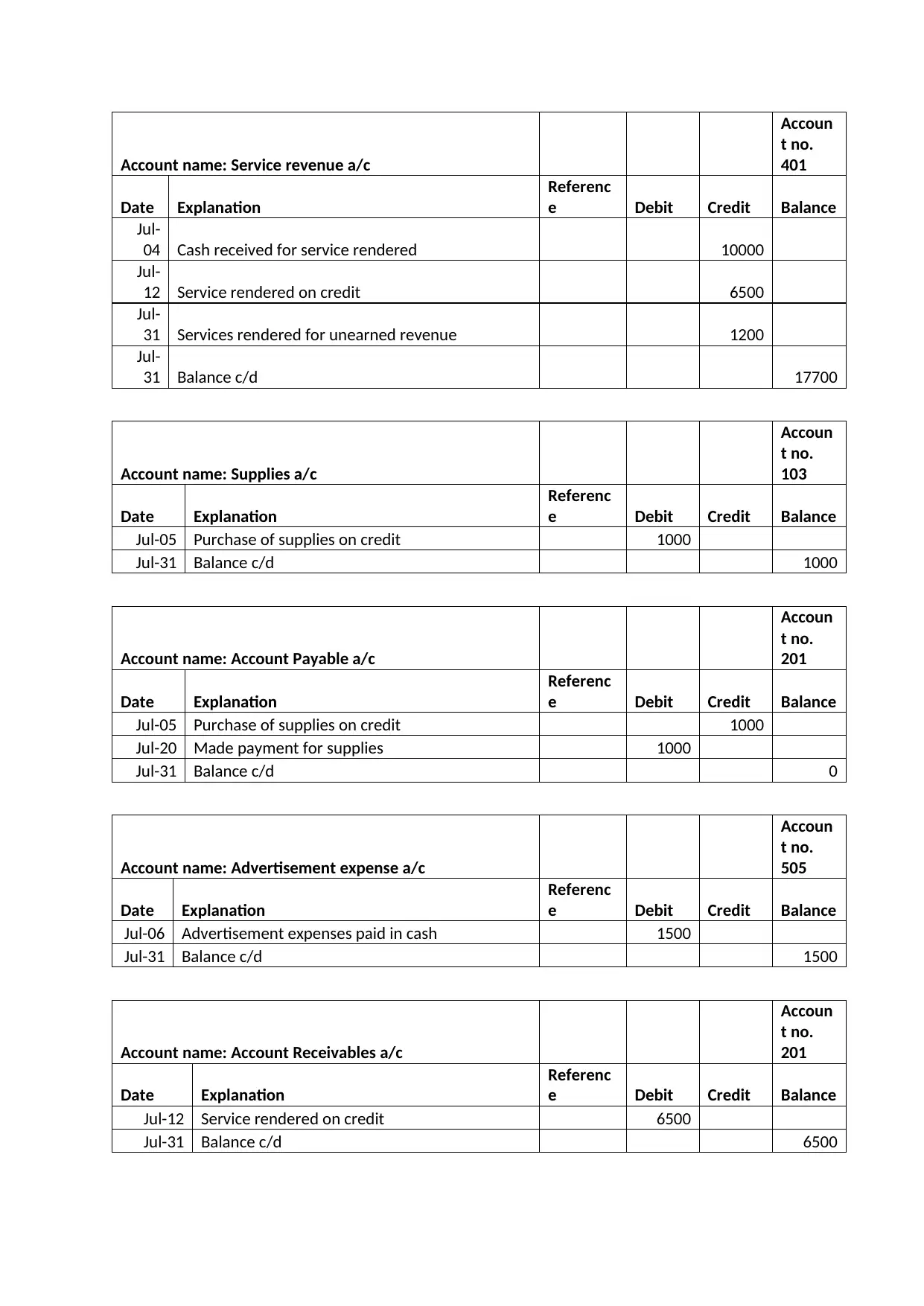
Account name: Service revenue a/c
Accoun
t no.
401
Date Explanation
Referenc
e Debit Credit Balance
Jul-
04 Cash received for service rendered 10000
Jul-
12 Service rendered on credit 6500
Jul-
31 Services rendered for unearned revenue 1200
Jul-
31 Balance c/d 17700
Account name: Supplies a/c
Accoun
t no.
103
Date Explanation
Referenc
e Debit Credit Balance
Jul-05 Purchase of supplies on credit 1000
Jul-31 Balance c/d 1000
Account name: Account Payable a/c
Accoun
t no.
201
Date Explanation
Referenc
e Debit Credit Balance
Jul-05 Purchase of supplies on credit 1000
Jul-20 Made payment for supplies 1000
Jul-31 Balance c/d 0
Account name: Advertisement expense a/c
Accoun
t no.
505
Date Explanation
Referenc
e Debit Credit Balance
Jul-06 Advertisement expenses paid in cash 1500
Jul-31 Balance c/d 1500
Account name: Account Receivables a/c
Accoun
t no.
201
Date Explanation
Referenc
e Debit Credit Balance
Jul-12 Service rendered on credit 6500
Jul-31 Balance c/d 6500
Accoun
t no.
401
Date Explanation
Referenc
e Debit Credit Balance
Jul-
04 Cash received for service rendered 10000
Jul-
12 Service rendered on credit 6500
Jul-
31 Services rendered for unearned revenue 1200
Jul-
31 Balance c/d 17700
Account name: Supplies a/c
Accoun
t no.
103
Date Explanation
Referenc
e Debit Credit Balance
Jul-05 Purchase of supplies on credit 1000
Jul-31 Balance c/d 1000
Account name: Account Payable a/c
Accoun
t no.
201
Date Explanation
Referenc
e Debit Credit Balance
Jul-05 Purchase of supplies on credit 1000
Jul-20 Made payment for supplies 1000
Jul-31 Balance c/d 0
Account name: Advertisement expense a/c
Accoun
t no.
505
Date Explanation
Referenc
e Debit Credit Balance
Jul-06 Advertisement expenses paid in cash 1500
Jul-31 Balance c/d 1500
Account name: Account Receivables a/c
Accoun
t no.
201
Date Explanation
Referenc
e Debit Credit Balance
Jul-12 Service rendered on credit 6500
Jul-31 Balance c/d 6500
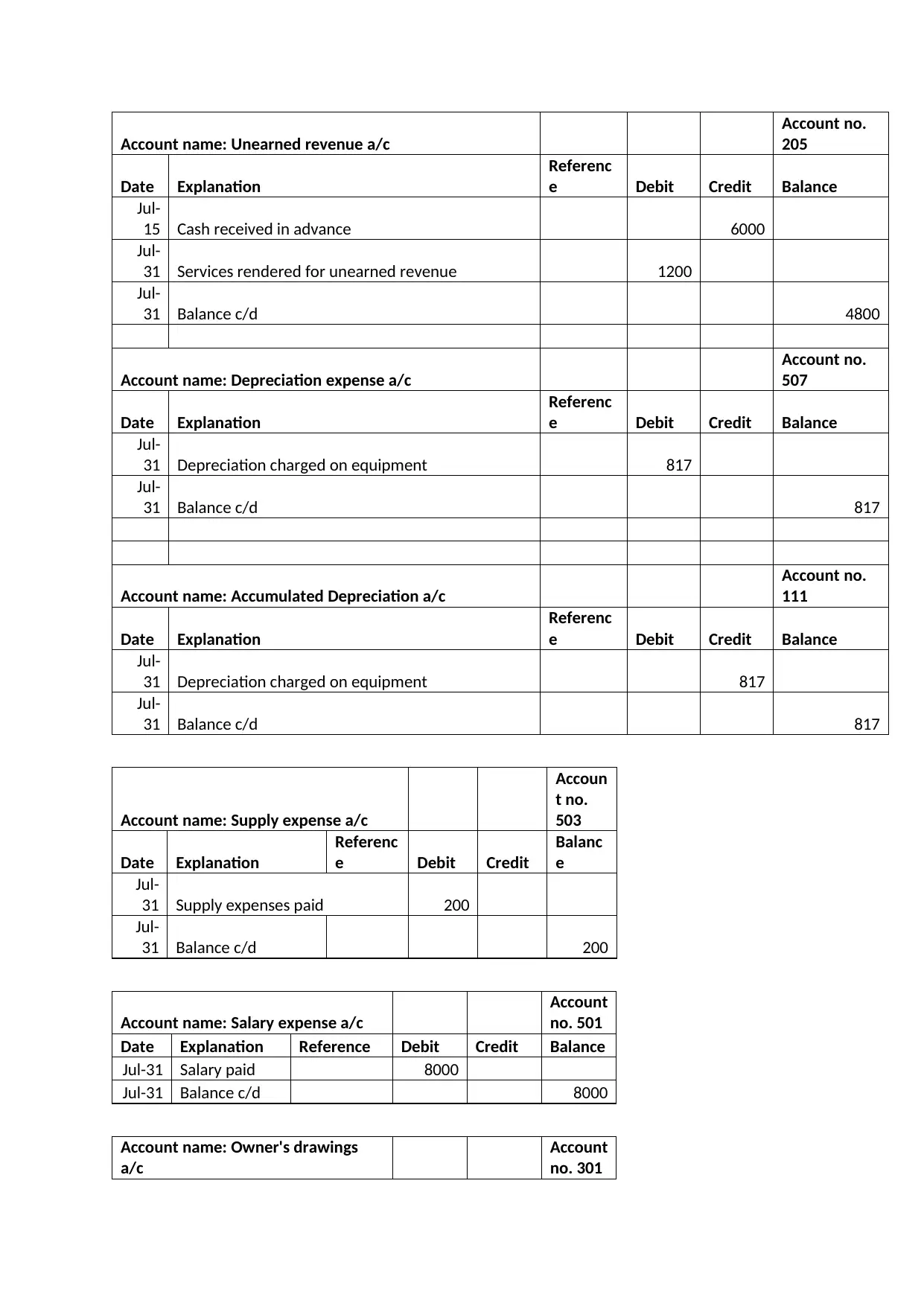
Account name: Unearned revenue a/c
Account no.
205
Date Explanation
Referenc
e Debit Credit Balance
Jul-
15 Cash received in advance 6000
Jul-
31 Services rendered for unearned revenue 1200
Jul-
31 Balance c/d 4800
Account name: Depreciation expense a/c
Account no.
507
Date Explanation
Referenc
e Debit Credit Balance
Jul-
31 Depreciation charged on equipment 817
Jul-
31 Balance c/d 817
Account name: Accumulated Depreciation a/c
Account no.
111
Date Explanation
Referenc
e Debit Credit Balance
Jul-
31 Depreciation charged on equipment 817
Jul-
31 Balance c/d 817
Account name: Supply expense a/c
Accoun
t no.
503
Date Explanation
Referenc
e Debit Credit
Balanc
e
Jul-
31 Supply expenses paid 200
Jul-
31 Balance c/d 200
Account name: Salary expense a/c
Account
no. 501
Date Explanation Reference Debit Credit Balance
Jul-31 Salary paid 8000
Jul-31 Balance c/d 8000
Account name: Owner's drawings
a/c
Account
no. 301
Account no.
205
Date Explanation
Referenc
e Debit Credit Balance
Jul-
15 Cash received in advance 6000
Jul-
31 Services rendered for unearned revenue 1200
Jul-
31 Balance c/d 4800
Account name: Depreciation expense a/c
Account no.
507
Date Explanation
Referenc
e Debit Credit Balance
Jul-
31 Depreciation charged on equipment 817
Jul-
31 Balance c/d 817
Account name: Accumulated Depreciation a/c
Account no.
111
Date Explanation
Referenc
e Debit Credit Balance
Jul-
31 Depreciation charged on equipment 817
Jul-
31 Balance c/d 817
Account name: Supply expense a/c
Accoun
t no.
503
Date Explanation
Referenc
e Debit Credit
Balanc
e
Jul-
31 Supply expenses paid 200
Jul-
31 Balance c/d 200
Account name: Salary expense a/c
Account
no. 501
Date Explanation Reference Debit Credit Balance
Jul-31 Salary paid 8000
Jul-31 Balance c/d 8000
Account name: Owner's drawings
a/c
Account
no. 301
Paraphrase This Document
Need a fresh take? Get an instant paraphrase of this document with our AI Paraphraser
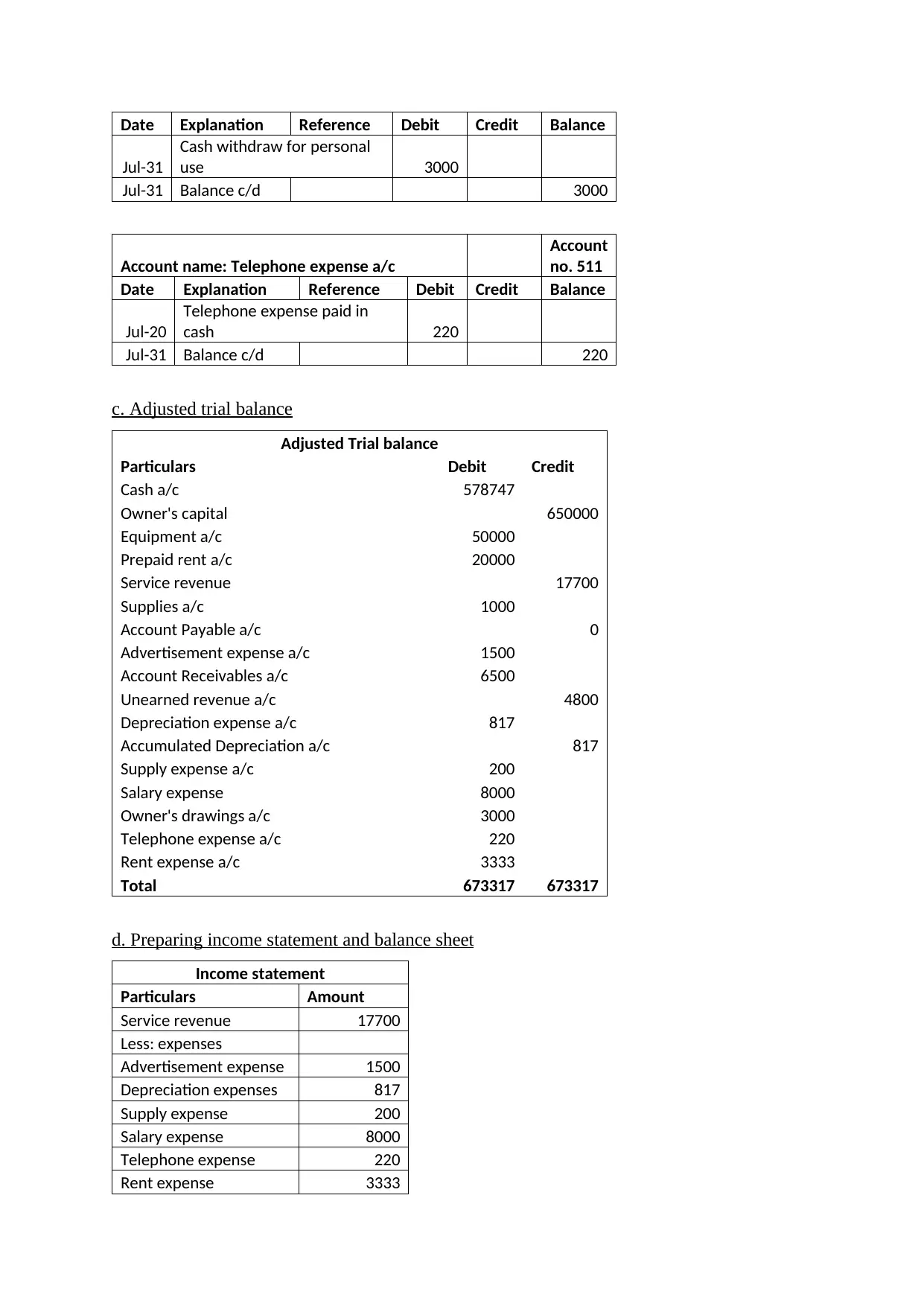
Date Explanation Reference Debit Credit Balance
Jul-31
Cash withdraw for personal
use 3000
Jul-31 Balance c/d 3000
Account name: Telephone expense a/c
Account
no. 511
Date Explanation Reference Debit Credit Balance
Jul-20
Telephone expense paid in
cash 220
Jul-31 Balance c/d 220
c. Adjusted trial balance
Adjusted Trial balance
Particulars Debit Credit
Cash a/c 578747
Owner's capital 650000
Equipment a/c 50000
Prepaid rent a/c 20000
Service revenue 17700
Supplies a/c 1000
Account Payable a/c 0
Advertisement expense a/c 1500
Account Receivables a/c 6500
Unearned revenue a/c 4800
Depreciation expense a/c 817
Accumulated Depreciation a/c 817
Supply expense a/c 200
Salary expense 8000
Owner's drawings a/c 3000
Telephone expense a/c 220
Rent expense a/c 3333
Total 673317 673317
d. Preparing income statement and balance sheet
Income statement
Particulars Amount
Service revenue 17700
Less: expenses
Advertisement expense 1500
Depreciation expenses 817
Supply expense 200
Salary expense 8000
Telephone expense 220
Rent expense 3333
Jul-31
Cash withdraw for personal
use 3000
Jul-31 Balance c/d 3000
Account name: Telephone expense a/c
Account
no. 511
Date Explanation Reference Debit Credit Balance
Jul-20
Telephone expense paid in
cash 220
Jul-31 Balance c/d 220
c. Adjusted trial balance
Adjusted Trial balance
Particulars Debit Credit
Cash a/c 578747
Owner's capital 650000
Equipment a/c 50000
Prepaid rent a/c 20000
Service revenue 17700
Supplies a/c 1000
Account Payable a/c 0
Advertisement expense a/c 1500
Account Receivables a/c 6500
Unearned revenue a/c 4800
Depreciation expense a/c 817
Accumulated Depreciation a/c 817
Supply expense a/c 200
Salary expense 8000
Owner's drawings a/c 3000
Telephone expense a/c 220
Rent expense a/c 3333
Total 673317 673317
d. Preparing income statement and balance sheet
Income statement
Particulars Amount
Service revenue 17700
Less: expenses
Advertisement expense 1500
Depreciation expenses 817
Supply expense 200
Salary expense 8000
Telephone expense 220
Rent expense 3333
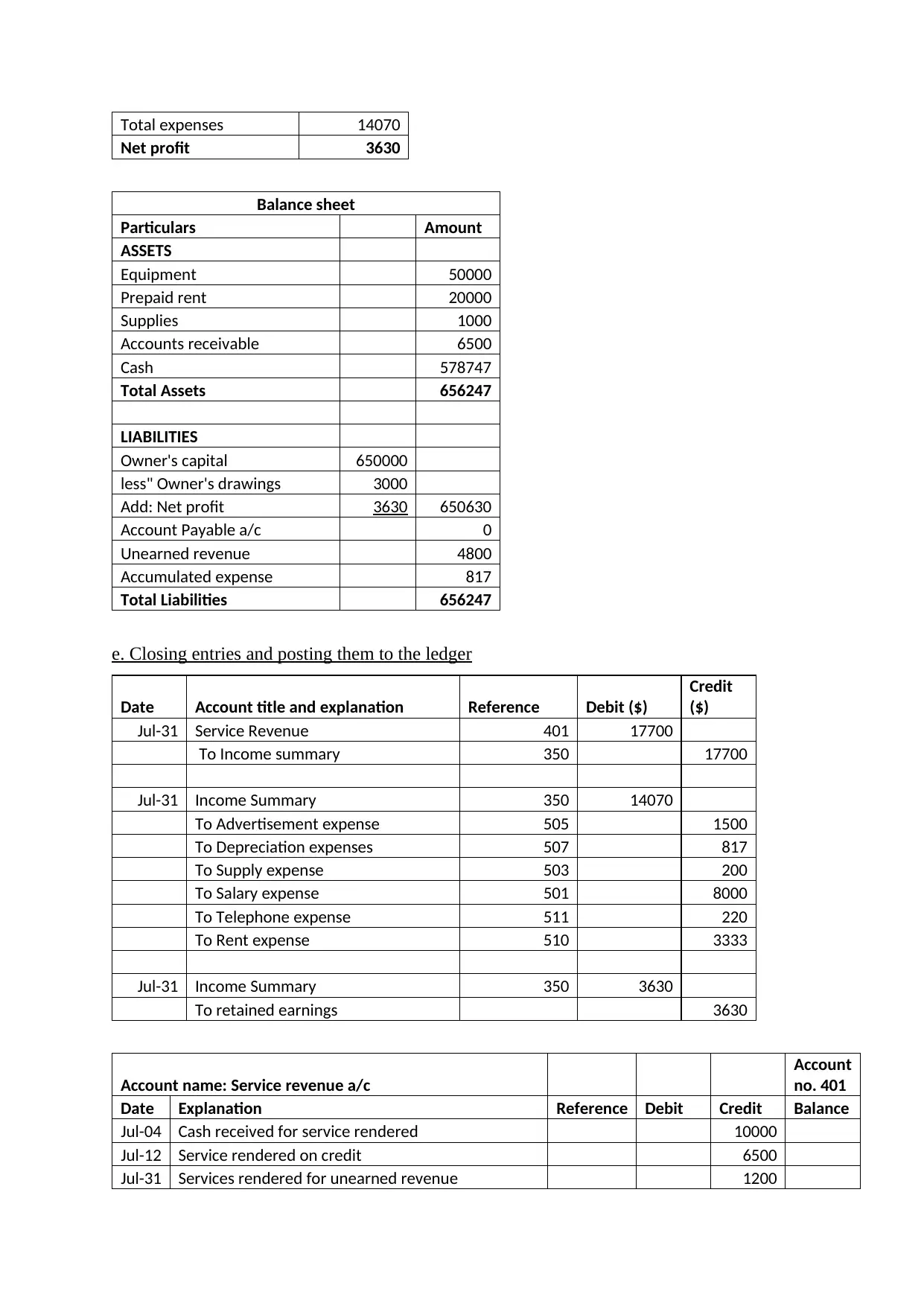
Total expenses 14070
Net profit 3630
Balance sheet
Particulars Amount
ASSETS
Equipment 50000
Prepaid rent 20000
Supplies 1000
Accounts receivable 6500
Cash 578747
Total Assets 656247
LIABILITIES
Owner's capital 650000
less" Owner's drawings 3000
Add: Net profit 3630 650630
Account Payable a/c 0
Unearned revenue 4800
Accumulated expense 817
Total Liabilities 656247
e. Closing entries and posting them to the ledger
Date Account title and explanation Reference Debit ($)
Credit
($)
Jul-31 Service Revenue 401 17700
To Income summary 350 17700
Jul-31 Income Summary 350 14070
To Advertisement expense 505 1500
To Depreciation expenses 507 817
To Supply expense 503 200
To Salary expense 501 8000
To Telephone expense 511 220
To Rent expense 510 3333
Jul-31 Income Summary 350 3630
To retained earnings 3630
Account name: Service revenue a/c
Account
no. 401
Date Explanation Reference Debit Credit Balance
Jul-04 Cash received for service rendered 10000
Jul-12 Service rendered on credit 6500
Jul-31 Services rendered for unearned revenue 1200
Net profit 3630
Balance sheet
Particulars Amount
ASSETS
Equipment 50000
Prepaid rent 20000
Supplies 1000
Accounts receivable 6500
Cash 578747
Total Assets 656247
LIABILITIES
Owner's capital 650000
less" Owner's drawings 3000
Add: Net profit 3630 650630
Account Payable a/c 0
Unearned revenue 4800
Accumulated expense 817
Total Liabilities 656247
e. Closing entries and posting them to the ledger
Date Account title and explanation Reference Debit ($)
Credit
($)
Jul-31 Service Revenue 401 17700
To Income summary 350 17700
Jul-31 Income Summary 350 14070
To Advertisement expense 505 1500
To Depreciation expenses 507 817
To Supply expense 503 200
To Salary expense 501 8000
To Telephone expense 511 220
To Rent expense 510 3333
Jul-31 Income Summary 350 3630
To retained earnings 3630
Account name: Service revenue a/c
Account
no. 401
Date Explanation Reference Debit Credit Balance
Jul-04 Cash received for service rendered 10000
Jul-12 Service rendered on credit 6500
Jul-31 Services rendered for unearned revenue 1200
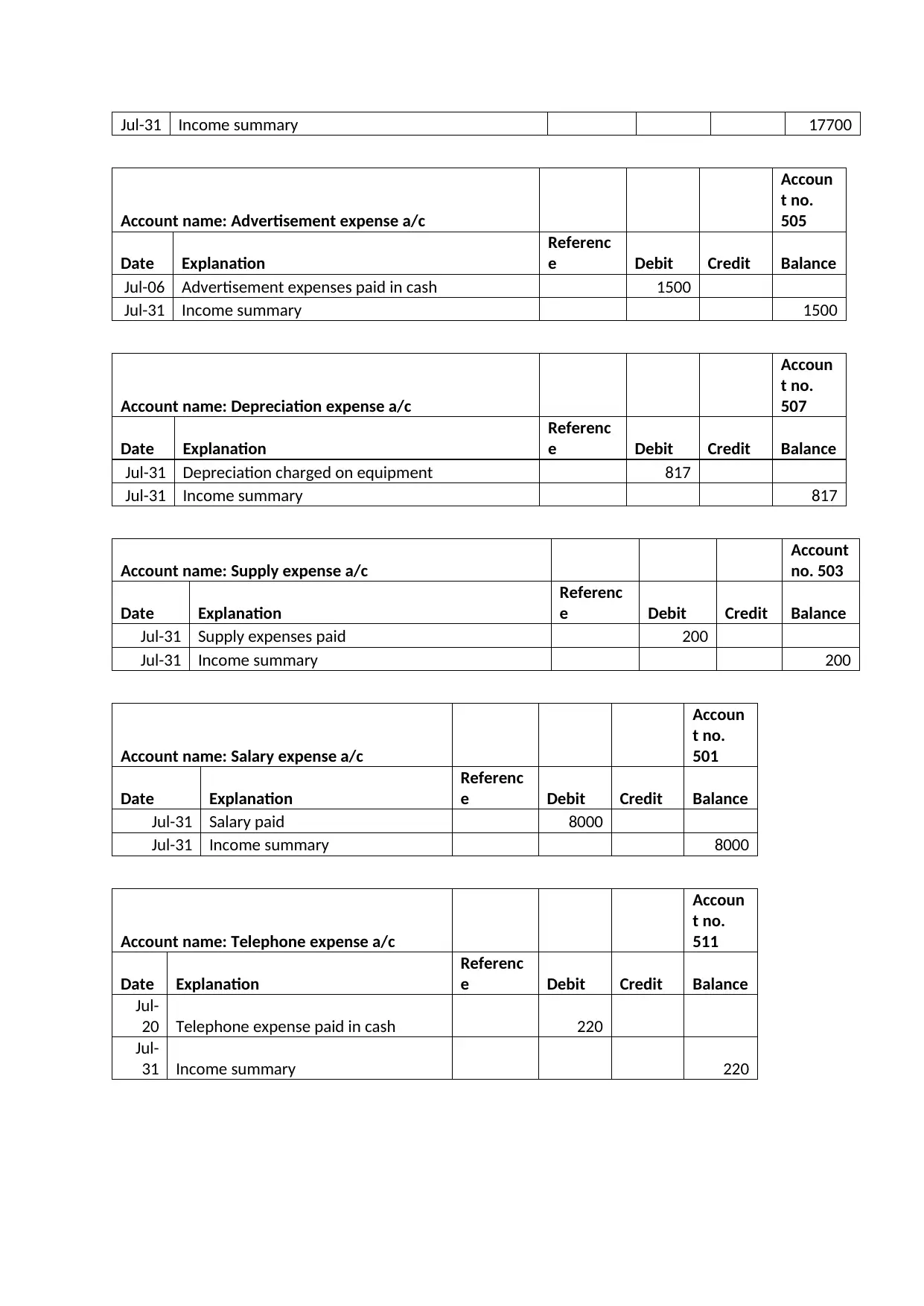
Jul-31 Income summary 17700
Account name: Advertisement expense a/c
Accoun
t no.
505
Date Explanation
Referenc
e Debit Credit Balance
Jul-06 Advertisement expenses paid in cash 1500
Jul-31 Income summary 1500
Account name: Depreciation expense a/c
Accoun
t no.
507
Date Explanation
Referenc
e Debit Credit Balance
Jul-31 Depreciation charged on equipment 817
Jul-31 Income summary 817
Account name: Supply expense a/c
Account
no. 503
Date Explanation
Referenc
e Debit Credit Balance
Jul-31 Supply expenses paid 200
Jul-31 Income summary 200
Account name: Salary expense a/c
Accoun
t no.
501
Date Explanation
Referenc
e Debit Credit Balance
Jul-31 Salary paid 8000
Jul-31 Income summary 8000
Account name: Telephone expense a/c
Accoun
t no.
511
Date Explanation
Referenc
e Debit Credit Balance
Jul-
20 Telephone expense paid in cash 220
Jul-
31 Income summary 220
Account name: Advertisement expense a/c
Accoun
t no.
505
Date Explanation
Referenc
e Debit Credit Balance
Jul-06 Advertisement expenses paid in cash 1500
Jul-31 Income summary 1500
Account name: Depreciation expense a/c
Accoun
t no.
507
Date Explanation
Referenc
e Debit Credit Balance
Jul-31 Depreciation charged on equipment 817
Jul-31 Income summary 817
Account name: Supply expense a/c
Account
no. 503
Date Explanation
Referenc
e Debit Credit Balance
Jul-31 Supply expenses paid 200
Jul-31 Income summary 200
Account name: Salary expense a/c
Accoun
t no.
501
Date Explanation
Referenc
e Debit Credit Balance
Jul-31 Salary paid 8000
Jul-31 Income summary 8000
Account name: Telephone expense a/c
Accoun
t no.
511
Date Explanation
Referenc
e Debit Credit Balance
Jul-
20 Telephone expense paid in cash 220
Jul-
31 Income summary 220
Secure Best Marks with AI Grader
Need help grading? Try our AI Grader for instant feedback on your assignments.
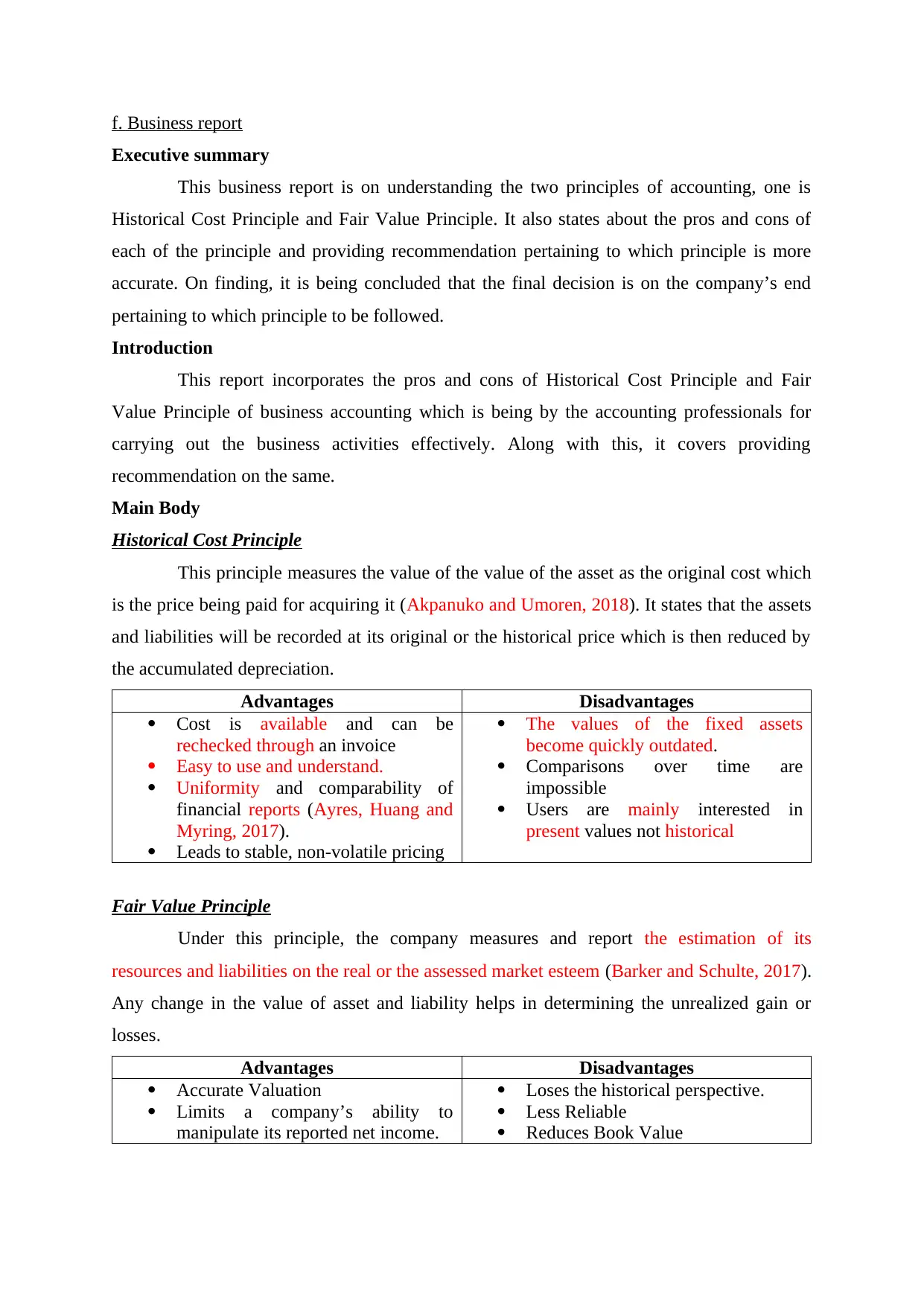
f. Business report
Executive summary
This business report is on understanding the two principles of accounting, one is
Historical Cost Principle and Fair Value Principle. It also states about the pros and cons of
each of the principle and providing recommendation pertaining to which principle is more
accurate. On finding, it is being concluded that the final decision is on the company’s end
pertaining to which principle to be followed.
Introduction
This report incorporates the pros and cons of Historical Cost Principle and Fair
Value Principle of business accounting which is being by the accounting professionals for
carrying out the business activities effectively. Along with this, it covers providing
recommendation on the same.
Main Body
Historical Cost Principle
This principle measures the value of the value of the asset as the original cost which
is the price being paid for acquiring it (Akpanuko and Umoren, 2018). It states that the assets
and liabilities will be recorded at its original or the historical price which is then reduced by
the accumulated depreciation.
Advantages Disadvantages
Cost is available and can be
rechecked through an invoice
Easy to use and understand.
Uniformity and comparability of
financial reports (Ayres, Huang and
Myring, 2017).
Leads to stable, non-volatile pricing
The values of the fixed assets
become quickly outdated.
Comparisons over time are
impossible
Users are mainly interested in
present values not historical
Fair Value Principle
Under this principle, the company measures and report the estimation of its
resources and liabilities on the real or the assessed market esteem (Barker and Schulte, 2017).
Any change in the value of asset and liability helps in determining the unrealized gain or
losses.
Advantages Disadvantages
Accurate Valuation
Limits a company’s ability to
manipulate its reported net income.
Loses the historical perspective.
Less Reliable
Reduces Book Value
Executive summary
This business report is on understanding the two principles of accounting, one is
Historical Cost Principle and Fair Value Principle. It also states about the pros and cons of
each of the principle and providing recommendation pertaining to which principle is more
accurate. On finding, it is being concluded that the final decision is on the company’s end
pertaining to which principle to be followed.
Introduction
This report incorporates the pros and cons of Historical Cost Principle and Fair
Value Principle of business accounting which is being by the accounting professionals for
carrying out the business activities effectively. Along with this, it covers providing
recommendation on the same.
Main Body
Historical Cost Principle
This principle measures the value of the value of the asset as the original cost which
is the price being paid for acquiring it (Akpanuko and Umoren, 2018). It states that the assets
and liabilities will be recorded at its original or the historical price which is then reduced by
the accumulated depreciation.
Advantages Disadvantages
Cost is available and can be
rechecked through an invoice
Easy to use and understand.
Uniformity and comparability of
financial reports (Ayres, Huang and
Myring, 2017).
Leads to stable, non-volatile pricing
The values of the fixed assets
become quickly outdated.
Comparisons over time are
impossible
Users are mainly interested in
present values not historical
Fair Value Principle
Under this principle, the company measures and report the estimation of its
resources and liabilities on the real or the assessed market esteem (Barker and Schulte, 2017).
Any change in the value of asset and liability helps in determining the unrealized gain or
losses.
Advantages Disadvantages
Accurate Valuation
Limits a company’s ability to
manipulate its reported net income.
Loses the historical perspective.
Less Reliable
Reduces Book Value
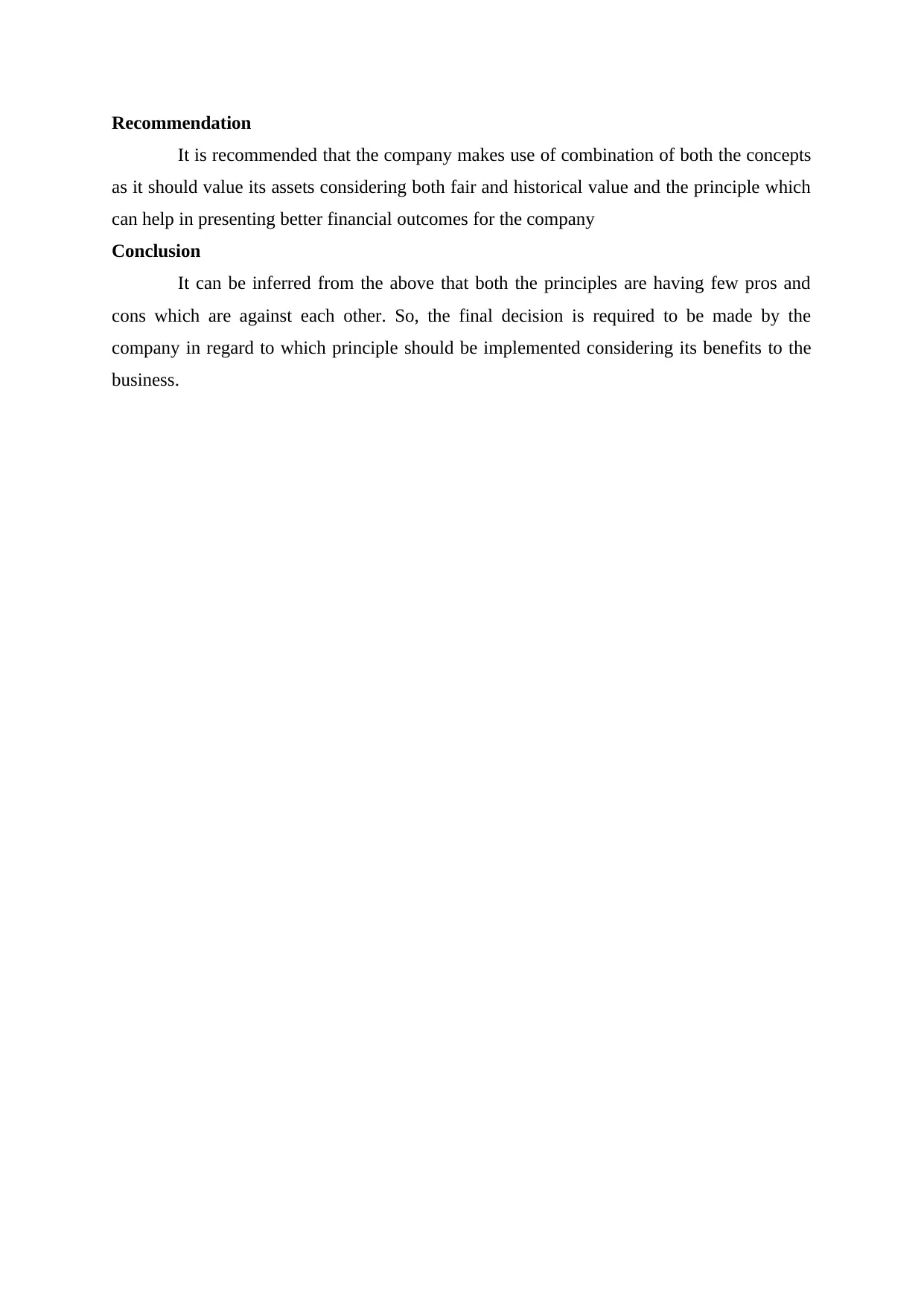
Recommendation
It is recommended that the company makes use of combination of both the concepts
as it should value its assets considering both fair and historical value and the principle which
can help in presenting better financial outcomes for the company
Conclusion
It can be inferred from the above that both the principles are having few pros and
cons which are against each other. So, the final decision is required to be made by the
company in regard to which principle should be implemented considering its benefits to the
business.
It is recommended that the company makes use of combination of both the concepts
as it should value its assets considering both fair and historical value and the principle which
can help in presenting better financial outcomes for the company
Conclusion
It can be inferred from the above that both the principles are having few pros and
cons which are against each other. So, the final decision is required to be made by the
company in regard to which principle should be implemented considering its benefits to the
business.
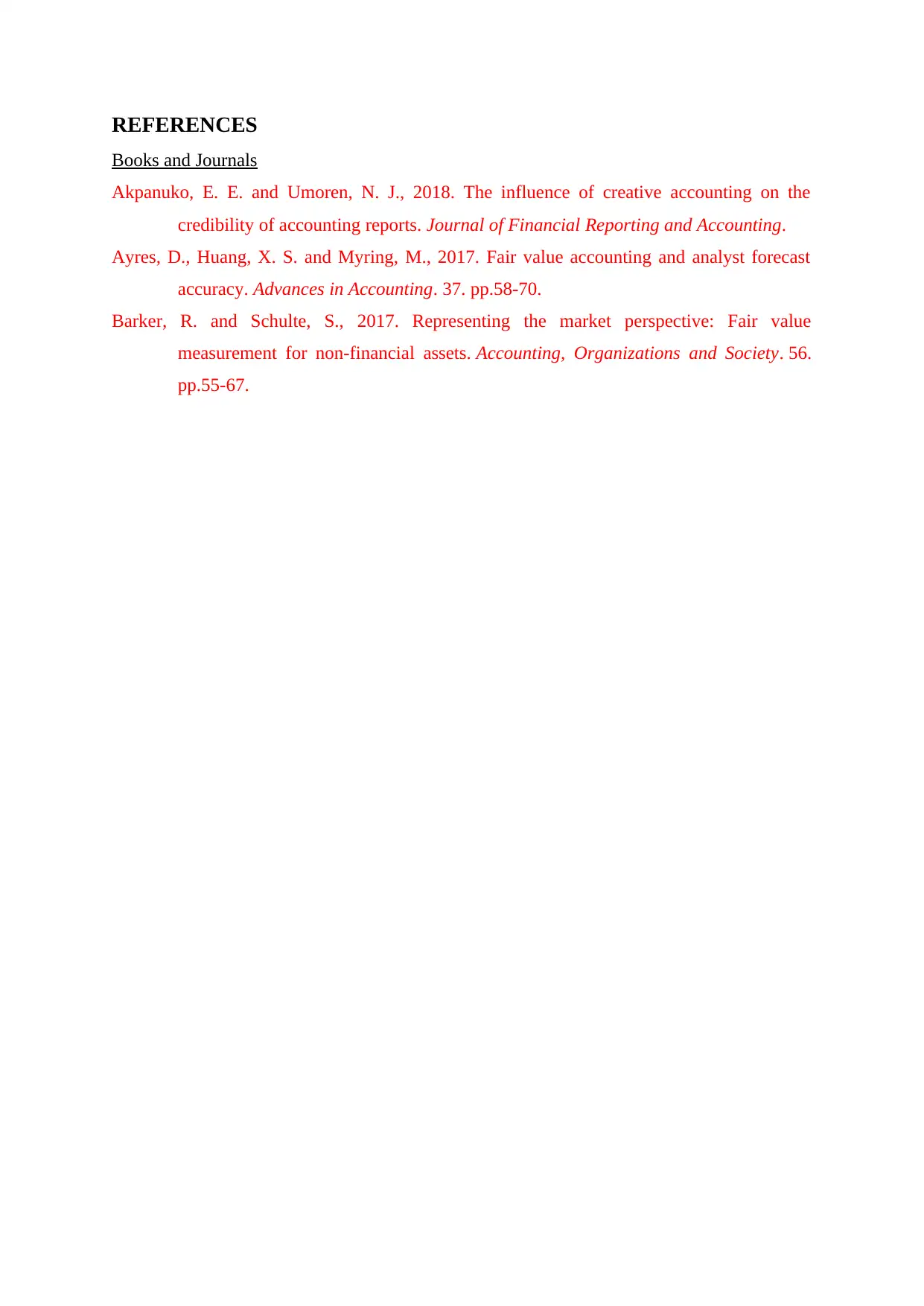
REFERENCES
Books and Journals
Akpanuko, E. E. and Umoren, N. J., 2018. The influence of creative accounting on the
credibility of accounting reports. Journal of Financial Reporting and Accounting.
Ayres, D., Huang, X. S. and Myring, M., 2017. Fair value accounting and analyst forecast
accuracy. Advances in Accounting. 37. pp.58-70.
Barker, R. and Schulte, S., 2017. Representing the market perspective: Fair value
measurement for non-financial assets. Accounting, Organizations and Society. 56.
pp.55-67.
Books and Journals
Akpanuko, E. E. and Umoren, N. J., 2018. The influence of creative accounting on the
credibility of accounting reports. Journal of Financial Reporting and Accounting.
Ayres, D., Huang, X. S. and Myring, M., 2017. Fair value accounting and analyst forecast
accuracy. Advances in Accounting. 37. pp.58-70.
Barker, R. and Schulte, S., 2017. Representing the market perspective: Fair value
measurement for non-financial assets. Accounting, Organizations and Society. 56.
pp.55-67.
1 out of 13
Related Documents
Your All-in-One AI-Powered Toolkit for Academic Success.
+13062052269
info@desklib.com
Available 24*7 on WhatsApp / Email
![[object Object]](/_next/static/media/star-bottom.7253800d.svg)
Unlock your academic potential
© 2024 | Zucol Services PVT LTD | All rights reserved.




